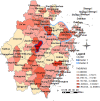Epidemiological profile of dengue in Zhejiang Province, southeast China
- PMID: 30533054
- PMCID: PMC6289432
- DOI: 10.1371/journal.pone.0208810
Epidemiological profile of dengue in Zhejiang Province, southeast China
Abstract
Background: Dengue is one of the most important vector-bore infectious diseases in China because of its drastic increase in incidence, geographic extension and profound influence on China's economy. This study aims to retrospectively uncover the epidemiological profile of dengue in Zhejiang, one of the most developed provinces in China, and to find the problem existing in dengue control and prevention.
Methodology: Descriptive analyses on the dengue incidence and associated factors were performed. We also identified potential space-time cluster and generated the risk map of dengue.
Principal findings: A total of 529 cases were reported in Zhejiang Province from 2005 to 2016, and 44.4% were imported. 67.7% of cases were 25~60 years old and the overall male-to-female sex ratio was 1.09:1. Dengue was reported all year round and 70.7% of cases occurred between August and October. Indigenous cases were only reported in the period between July to November and more than half occurred in September. Geographically, dengue was most distributed in Jinghua (3.62 per million), Shaoxing (1.00 per million) and Taizhou (0.81 per million) prefecture level cities. Outbreaks were confirmed in Yiwu, Keqiao and Huangyan counties in 2009, 2015, and 2016, respectively. 73.9% cases would seek medical advice within two days after onset and be confirmed within 9 days after onset. 75.6% would be recognized as dengue within 8 days after their first visit. The time intervals between onset and confirmation (median 7 vs 6 days; Wilcoxon rank sum test Z = -2.40, P = 0.016), first visit and confirmation (median 7 vs 6 days; Wilcoxon rank sum test Z = -2.59, P = 0.009) of indigenous cases were significantly longer than those of imported ones. However, the time intervals between onset and first visit for indigenous cases was shorter (median 0 vs 1 days; Wilcoxon rank sum test Z = -2.10, P = 0.036). Fever (99.1%), fatigue (81.9), rash (63.7%), headache (67.2%) and myalgia (52.60%) were the most frequently mentioned symptoms.
Conclusions: Zhejiang has recently witnessed an increase in incidence and geographic extension of dengue. Timely diagnosis is important to stop local transmission and outbreak.
Conflict of interest statement
The authors have declared that no competing interests exist.
Figures





Similar articles
-
Epidemiology of Indigenous Dengue Cases in Zhejiang Province, Southeast China.Front Public Health. 2022 Apr 14;10:857911. doi: 10.3389/fpubh.2022.857911. eCollection 2022. Front Public Health. 2022. PMID: 35493348 Free PMC article.
-
Epidemiological Characterization of the 2017 Dengue Outbreak in Zhejiang, China and Molecular Characterization of the Viruses.Front Cell Infect Microbiol. 2018 Jul 4;8:216. doi: 10.3389/fcimb.2018.00216. eCollection 2018. Front Cell Infect Microbiol. 2018. PMID: 30023351 Free PMC article.
-
Incidence dynamics and investigation of key interventions in a dengue outbreak in Ningbo City, China.PLoS Negl Trop Dis. 2019 Aug 15;13(8):e0007659. doi: 10.1371/journal.pntd.0007659. eCollection 2019 Aug. PLoS Negl Trop Dis. 2019. PMID: 31415559 Free PMC article.
-
Epidemiological and cluster characteristics of dengue fever in Yunnan Province, Southwestern China, 2013-2023.BMC Infect Dis. 2025 Jan 21;25(1):95. doi: 10.1186/s12879-024-10403-2. BMC Infect Dis. 2025. PMID: 39838306 Free PMC article.
-
[Epidemiology of dengue fever in China since 1978].Nan Fang Yi Ke Da Xue Xue Bao. 2014 Dec;34(12):1822-5. Nan Fang Yi Ke Da Xue Xue Bao. 2014. PMID: 25537911 Review. Chinese.
Cited by
-
Role of vector phenotypic plasticity in disease transmission as illustrated by the spread of dengue virus by Aedes albopictus.Nat Commun. 2024 Sep 7;15(1):7823. doi: 10.1038/s41467-024-52144-5. Nat Commun. 2024. PMID: 39242617 Free PMC article.
-
Global prevalence and risk factors of fatigue and post-infectious fatigue among patients with dengue: a systematic review and meta-analysis.EClinicalMedicine. 2024 Dec 31;80:103041. doi: 10.1016/j.eclinm.2024.103041. eCollection 2025 Feb. EClinicalMedicine. 2024. PMID: 39844930 Free PMC article.
-
The epidemiology and disease burden of children hospitalized for viral infections within the family Flaviviridae in China: A national cross-sectional study.PLoS Negl Trop Dis. 2022 Jul 5;16(7):e0010562. doi: 10.1371/journal.pntd.0010562. eCollection 2022 Jul. PLoS Negl Trop Dis. 2022. PMID: 35788743 Free PMC article.
-
Ecological features and insecticide resistance of Aedes albopictus in Xi'an, a high-risk dengue transmission area in China.PeerJ. 2024 Oct 22;12:e18246. doi: 10.7717/peerj.18246. eCollection 2024. PeerJ. 2024. PMID: 39465170 Free PMC article.
-
Post-viral fatigue in COVID-19: A review of symptom assessment methods, mental, cognitive, and physical impairment.Neurosci Biobehav Rev. 2022 Nov;142:104902. doi: 10.1016/j.neubiorev.2022.104902. Epub 2022 Oct 3. Neurosci Biobehav Rev. 2022. PMID: 36202253 Free PMC article. Review.
References
-
- Dengue: Guidelines for Diagnosis, Treatment, Prevention and Control: New Edition. In Geneva, Switzerland: World Health Organization; 2009. - PubMed
-
- Brady OJ, Gething PW, Bhatt S, Messina JP, Brownstein JS, Hoen AG, et al. Refining the global spatial limits of dengue virus transmission by evidence-based consensus. PLoS Negl Trop Dis 2012, 6(8):e1760 10.1371/journal.pntd.0001760 - DOI - PMC - PubMed
-
- Stanaway JD, Shepard DS, Undurraga EA, Halasa YA, Coffeng LE, Brady OJ, et al. The global burden of dengue: an analysis from the Global Burden of Disease Study 2013. Lancet Infect Dis 2016, 6(16):712–723. 10.1016/S1473-3099(16)00026-8 - DOI - PMC - PubMed
-
- Shepard DS, Undurraga EA, Halasa YA, Stanaway JD. The global economic burden of dengue: a systematic analysis. Lancet Infect Dis 2016, 16(8):935–941. 10.1016/S1473-3099(16)00146-8 - DOI - PubMed
-
- Wilson ME, Chen LH. Dengue: Update on Epidemiology. Curr Infect Dis Rep 2015, 17(1):457–465. 10.1007/s11908-014-0457-2 - DOI - PubMed
Publication types
MeSH terms
LinkOut - more resources
Full Text Sources
Medical

